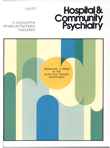Joint Treatment of Drug Addicts and Other Psychiatric Patients
Abstract
The authors describe the advantages and disadvantages of including drug addicts in a therapeutic community program with patients who have a primary psychiatric diagnosis arni with alcoholics. The three types of patients initially tended to focus on thefr own kinds of symptoms in group therapy, and to disdain one another, but soon caine to recognize that they have much in common. When the therapy groups included two addicts for every three nonaddicts, the groups were lively and progrersive. However, as addicts began to outnumber other patients in the program, therapeutic and administrative problems arose.
Access content
To read the fulltext, please use one of the options below to sign in or purchase access.- Personal login
- Institutional Login
- Sign in via OpenAthens
- Register for access
-
Please login/register if you wish to pair your device and check access availability.
Not a subscriber?
PsychiatryOnline subscription options offer access to the DSM-5 library, books, journals, CME, and patient resources. This all-in-one virtual library provides psychiatrists and mental health professionals with key resources for diagnosis, treatment, research, and professional development.
Need more help? PsychiatryOnline Customer Service may be reached by emailing [email protected] or by calling 800-368-5777 (in the U.S.) or 703-907-7322 (outside the U.S.).



